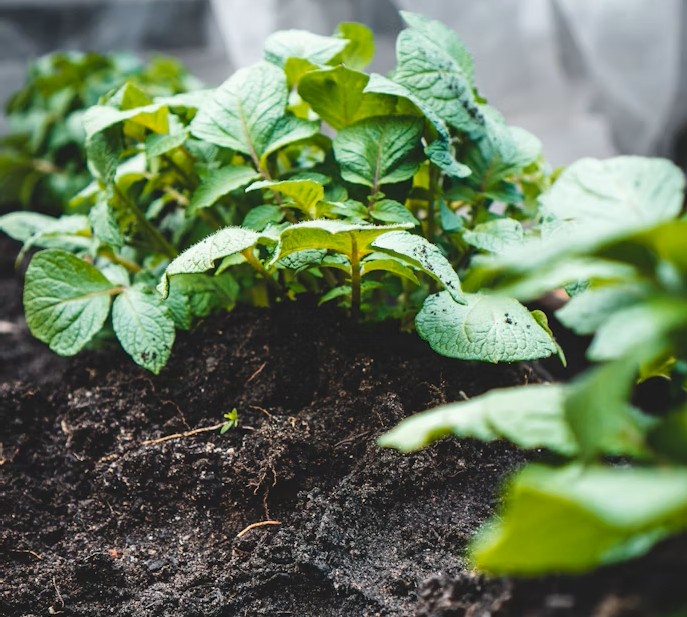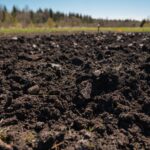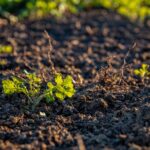Potassium humate liquid is a water-soluble, organic formulation derived from humic substances, primarily used in agriculture to enhance soil health, improve nutrient uptake, and promote plant growth. It is the liquid counterpart to potassium humate powder, offering similar benefits but with the added convenience of being pre-dissolved for immediate use in applications like foliar sprays, fertigation, and hydroponics.
What is Potassium Humate Liquid?
Potassium humate liquid is a concentrated solution made by dissolving potassium humate, the potassium salt of humic acid, in water. It is produced from humic substances extracted from natural sources like leonardite or lignite, which are rich in organic matter formed from decomposed plant and animal residues over millennia. The extraction process involves treating these materials with potassium hydroxide (KOH) to create a soluble product containing humic and fulvic acids, along with potassium, which serves as both a nutrient and a soil conditioner.
The liquid form is particularly valued for its ease of use, as it eliminates the need for manual dissolution and can be applied directly through irrigation systems, sprayers, or hydroponic setups. It is dark brown to black in color, with a slightly alkaline pH (typically 8.5–9.0), and is designed for rapid absorption by plants and soils. Potassium humate liquid is widely used in conventional and organic farming to improve crop productivity, soil fertility, and environmental sustainability.
Composition and Characteristics
Potassium humate liquid shares the same core components as its powder form but is formulated for immediate application. Key characteristics include:
- Humic Acid Content: Typically 10–20% in liquid formulations, though high-potency products may contain up to 25%. Humic acid improves soil structure and nutrient retention.
- Fulvic Acid Content: Usually 1–5%, aiding in nutrient absorption by plants due to its smaller molecular size.
- Potassium Content: Provides 2–5% soluble potash (K₂O), contributing to plant processes like water regulation, enzyme activation, and fruit development.
- Solubility: Fully water-soluble across a wide pH range (typically above pH 5.5), making it versatile for various application methods.
- Appearance and Consistency: A dark, viscous liquid that may require gentle shaking before use to ensure uniformity.
- pH Level: Slightly alkaline (pH 8.5–9.0), though some formulations are adjusted for compatibility with acidic soils or nutrient solutions.
- Source Material: High-quality liquid is derived from leonardite, which has a higher humic content than lignite or peat. Lower-quality sources may result in less effective products with higher impurities.
The concentration of active ingredients varies by product, so it’s important to check the label for humic acid, fulvic acid, and potassium content to ensure quality and suitability for specific needs.
Benefits of Potassium Humate Liquid
Potassium humate liquid offers a range of benefits for soil health, plant growth, and sustainable agriculture. Its liquid form makes it particularly effective for quick delivery and absorption. Below are the key advantages:
- Enhanced Nutrient Uptake:
- The humic and fulvic acids in potassium humate liquid act as natural chelators, binding nutrients like nitrogen, phosphorus, potassium, and micronutrients (e.g., iron, zinc, manganese) in forms that plants can easily absorb.
- This reduces nutrient leaching, especially in sandy or heavily irrigated soils.
- Improved Soil Structure:
- When applied to soil, potassium humate liquid promotes the formation of soil aggregates, improving aeration, water retention, and root penetration.
- In clay soils, it reduces stickiness and compaction, making the soil easier to till. In sandy soils, it increases the soil’s ability to hold water and nutrients, reducing irrigation frequency.
- Stimulated Plant Growth:
- The fulvic acid component enhances root development, leading to stronger, more extensive root systems that improve water and nutrient uptake.
- It also boosts seed germination and early seedling growth. For instance, farmers growing rice or soybeans may use potassium humate liquid as a seed treatment to achieve faster, more uniform sprouting.
- Plants treated with potassium humate liquid show increased resilience to environmental stresses, such as drought, salinity, or temperature extremes, which is critical in regions with unpredictable weather.
- Increased Fertilizer Efficiency:
- By reducing nutrient loss through leaching or volatilization, potassium humate liquid allows farmers to use less fertilizer while maintaining or improving crop yields. This lowers input costs and reduces environmental impacts like nutrient runoff into waterways.
- For example, when combined with liquid NPK fertilizers, potassium humate can improve nutrient delivery to crops like maize, reducing the need for frequent applications.
- Support for Soil Microorganisms:
- Potassium humate liquid provides organic carbon that feeds beneficial soil microbes, such as nitrogen-fixing bacteria and mycorrhizal fungi. These microbes enhance nutrient cycling and improve long-term soil fertility.
- In organic farming, this microbial boost is particularly valuable for maintaining healthy, productive soils without synthetic inputs.
- Environmental Sustainability:
- By minimizing nutrient runoff, potassium humate liquid helps prevent water pollution, such as algal blooms in rivers or lakes. Its organic nature aligns with sustainable farming practices and is approved for use in certified organic systems by organizations like the USDA or EU organic regulators.
- Ease of Application:
- The liquid form is ready to use, saving time and labor compared to dissolving powder. It’s especially convenient for large-scale operations using fertigation or foliar spray systems.
Applications in Agriculture
Potassium humate liquid is highly versatile and can be applied in various ways depending on the crop, soil type, and farming system. Below are the primary methods of application, with practical examples:
- Foliar Spray:
- Purpose: To deliver nutrients and growth stimulants directly to plant leaves for rapid absorption.
- Method: Dilute the liquid to a concentration of 0.1–0.5% (e.g., 1–5 mL per liter of water) and apply using a sprayer. Spray every 7–14 days during key growth stages, such as vegetative growth, flowering, or fruit set.
- Fertigation (Drip or Sprinkler Systems):
- Purpose: To supply nutrients and humic substances through irrigation systems, ideal for high-value crops.
- Method: Add 1–10 liters of potassium humate liquid per hectare to the irrigation water, depending on crop needs and system capacity. Apply during key growth stages for best results.
- Soil Drench:
- Purpose: To improve soil health and nutrient availability directly at the root zone.
- Method: Dilute the liquid (e.g., 1–2% solution) and apply 2–10 liters per hectare directly to the soil around plant roots, typically during planting or early growth.
- Seed Treatment:
- Purpose: To improve germination rates and early seedling vigor.
- Method: Dilute to a 1–2% solution and soak seeds for 6–12 hours before planting, or apply as a seed coating.
- Hydroponics:
- Purpose: To enhance nutrient uptake and root health in soilless systems.
- Method: Add 0.5–2 mL of potassium humate liquid per gallon of nutrient solution, adjusting based on crop response and system requirements.
- Other Uses:
- In aquaculture, potassium humate liquid can improve water quality by binding toxins and supporting beneficial microorganisms.
- In landscaping, it’s used to revitalize turf or ornamental plants, promoting lush growth and stress resistance.
Application Guidelines and Best Practices
To achieve optimal results with potassium humate liquid, follow these practical guidelines:
- Dosage: Adjust rates based on crop type, soil conditions, and application method. For example:
- Foliar sprays: 1–5 mL per liter of water.
- Fertigation: 1–10 liters per hectare.
- Soil drench: 2–10 liters per hectare, diluted to 1–2% concentration.
- Hydroponics: 0.5–2 mL per gallon of nutrient solution.
- Timing: Apply during critical growth stages for maximum impact:
- Post-seedling stage: When plants cover about 25% of the ground, to support early growth.
- Pre-flowering: To enhance flower formation and fruit set.
- Early fruit/grain sizing: To improve quality and yield.
- Mixing: Shake the liquid well before use to ensure uniformity. When mixing with other fertilizers or pesticides, conduct a compatibility test (e.g., mix small amounts in a jar) to avoid precipitation or reduced efficacy. Avoid combining with carbonate-based pesticides or highly acidic solutions (pH below 5.5).
- Soil Testing: Test soil for pH, nutrient levels, and organic matter content before application. Potassium humate liquid is most effective in slightly acidic to neutral soils (pH 5.5–7.5) but can be used in alkaline soils with adjustments.
- Equipment: Use clean, calibrated sprayers or irrigation systems to ensure even application. Rinse equipment after use to prevent residue buildup.
- Storage: Store in a cool, dry place away from direct sunlight to maintain product stability. Seal containers tightly to prevent evaporation or contamination.
- Safety: Potassium humate liquid is non-toxic and environmentally safe, but handle it with care to avoid skin or eye irritation. Wear gloves and protective clothing during application, and clean up spills promptly to avoid waste.
Environmental and Economic Impact
Potassium humate liquid supports sustainable agriculture by reducing nutrient runoff, which helps prevent environmental issues like eutrophication in water bodies. Its organic composition aligns with consumer demand for eco-friendly food production, making it a valuable tool for farmers targeting organic or premium markets. Economically, it can lower input costs by improving fertilizer efficiency and increasing crop yields, particularly in challenging soils or climates.
Comparison with Potassium Humate Powder
While potassium humate liquid and powder share the same core benefits, the liquid form has distinct advantages and considerations:
- Advantages of Liquid:
- Ready-to-use, saving time and labor compared to dissolving powder.
- Ideal for foliar sprays, fertigation, and hydroponics due to its pre-dissolved form.
- Easier to apply uniformly in large-scale operations with irrigation systems.
- Considerations:
- Liquid formulations may have a lower humic acid concentration (e.g., 10–20% vs. 60–95% in powder), requiring higher volumes for equivalent effects.
- Liquids are bulkier to transport and store compared to powder.
- Powder may be more cost-effective for soil applications on large fields, while liquid is better suited for precise, frequent applications like foliar sprays.
Conclusion
Potassium humate liquid is a versatile, user-friendly product that enhances soil fertility, improves nutrient uptake, and promotes robust plant growth. Its liquid form makes it particularly suitable for foliar sprays, fertigation, and hydroponic systems, offering convenience and rapid results for farmers and growers. By improving fertilizer efficiency, supporting soil health, and reducing environmental impact, it aligns with sustainable agriculture goals and is suitable for both conventional and organic farming. Proper application, tailored to crop and soil needs, ensures maximum benefits, such as higher yields, better crop quality, and long-term soil fertility.









